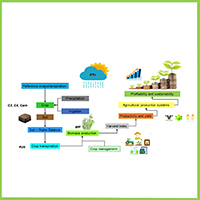Cropping pattern simulation-optimization model for water use efficiency and economic return

All claims expressed in this article are solely those of the authors and do not necessarily represent those of their affiliated organizations, or those of the publisher, the editors and the reviewers. Any product that may be evaluated in this article or claim that may be made by its manufacturer is not guaranteed or endorsed by the publisher.
Authors
Sustainable agricultural development is one of the most important tools for the economic growth of a country. Therefore, water and land use management is considered a priority. This research aimed to develop a framework to optimize crops’ spatial and temporal distribution in an irrigation district. The AquaCrop- OS (FAO) water productivity model was integrated with a nonlinear optimization model to maximize the annual net profitability and minimize the water consumption of three crops (rice, corn, and forage). It was applied at a regional level to 905 simulation sub-units in the Zulia irrigation district (Colombia), in three typical climatic years’ scenarios, and at a multi-period level (monthly). The results indicated that: i) crop simulation for the study area was applicable and feasible; ii) rice can be combined with forage and corn; iii) corn is a viable option under dry year conditions; iv) under a wet year, forage production is the best option. On average, in the dry year, profitability decreased by 14.5% compared to the normal year in half of the study area, and in some areas, economic losses of up to 53% were obtained. In the wet year, profitability remained at the same level as the normal year in 43.8% of the area. However, there were significant decreases in profitability in 23.1% of the district. In the normal year, the water demand of the crops in each simulated period allows savings of up to 50% of water compared to the current concession amount, which is 1000 mm. This study is useful for making decisions on sustainable resources management and optimal irrigation water and land use under different biophysical and economic conditions.
How to Cite

This work is licensed under a Creative Commons Attribution-NonCommercial 4.0 International License.














